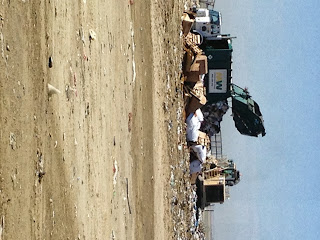Zachary Finken
September 11, 2013
Denver’s Grand Masterpiece: DADS
While
some people wish to escape debts, the grind of eight to five desk-work or break
free from prison, the one thing they will never escape is the downward spiral
of having to figure out where to put all their trash. For most, the answer is
collecting it inside the house then taking it outside the house where it will
disappear before the end of the day thanks to local trash trucks we see in the
photo above. Others like artist Chris Jordan create inspiring trash-based
pieces and innovative people are now even creating homes out of trash. Little
do the people of Arapahoe and Denver counties know, they are also creating
their own art just outside of Aurora at DADS; a masterpiece that won’t be
complete for approximately 129 years and that will require the help of each
citizen and visitor.
With
millions of people working everyday to complete the community’s masterpiece,
it’s disappointing to see what the DADS landfill actually looks like. When I
imagined the site before visiting, I pictured deep canyons full of trash on top
of more foul trash that the landfill management, in this case Waste Management,
would top off with dirt after the entire hole was full. However, my visit to
the landfill greatly differed from my premonitions. What happens to the nose
cringing trash smell between trash pick-up on the street and the ending
dump-off at DADS is a mysterious phenomenon. To my surprise, the air smelt
Colorado-fresh and my Grand Trash Canyon was nowhere to be found but my
reaction to what I did find instead left me in awe. As I stood atop one of the
trash mounds and realized that digging down would lead me to over a hundred
feet of trash. What could be found in all that trash? Very likely something I
threw away on a visit to Denver multiple years before or ramen noodles I threw
away just this week. My participation in the accumulation of all this buried
trash underneath my feet became apparent and real. The photo above shows not
only my connection but everyone else in the community’s connection to the
landfill as well. I give my trash directly to the trash pick-up and it is
directly dumped in the landfill. Not only my own waste is deposited here but enough
waste from enough people that it will take longer than my entire lifespan to
fill up the site.
Intriguingly,
the DADS landfill is more intricate than it appears with methane gas harnessing
technology operated by Waste Management. It seems so simple; the trash is
buried and the gas rises, is trapped and processed. But in reality the trash from millions of
people is only powering the homes of a meager 3,000. We cannot continue to bury
our problems at DADS for 129 years with such a low yield of output. As Fritjof Capra
suggest, “the more we study the major problems of our time the more we come to
realize that they cannot be understood in isolation. They are… interconnected
and interdependent.” The problem of trash grows faster than humans can work to
contain it. The boomerang effects it produces in our daily lives make the
journey to solving such an interconnected and interdependent situation an
arduous and lengthy process. Having the opportunity to be involved in the
process and walk on top of the DADS landfill was an eye-opening experience yet
reassuring to now know where my trash will go after I dismiss it into trash can
oblivion.


No comments:
Post a Comment